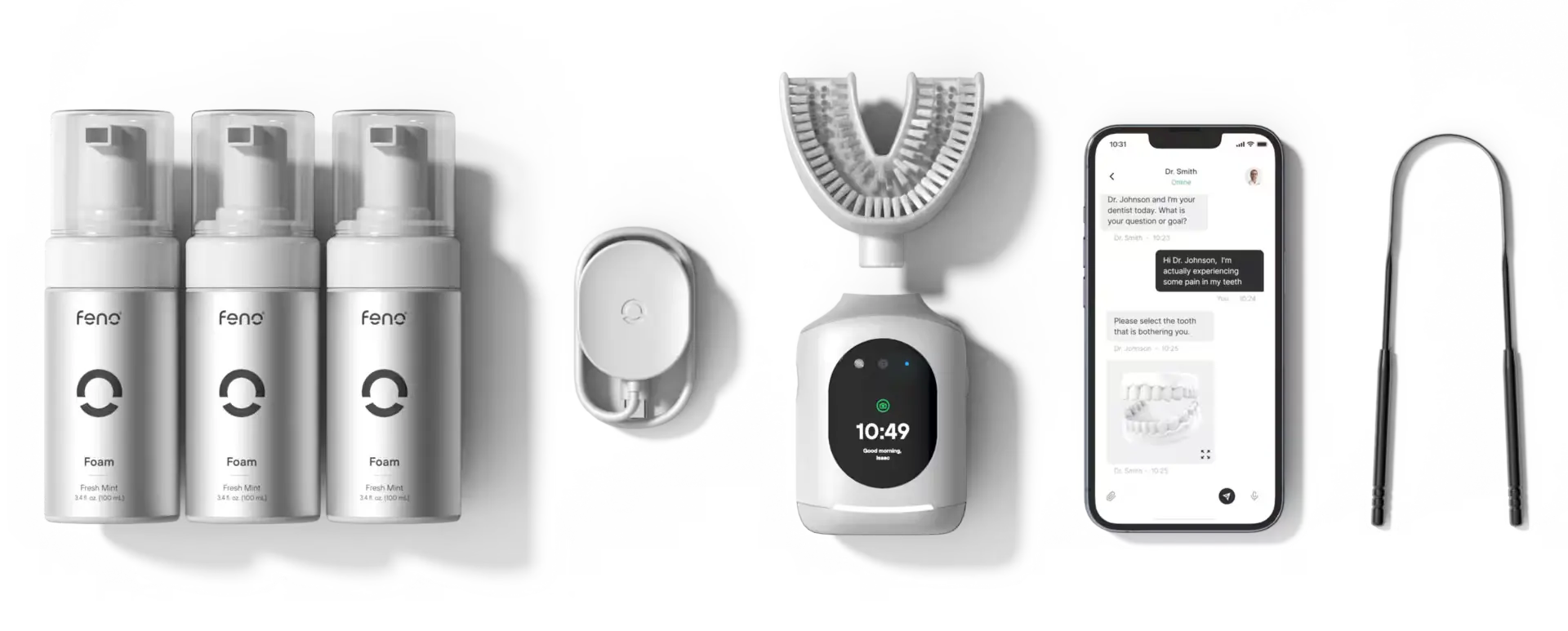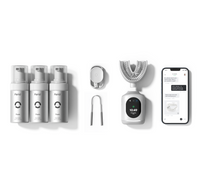
11 min read
A Comprehensive Guide to Transforming Your Brushing Routine with Smart Toothbrushes
The journey from manual toothbrushes to the advanced dental care technologies we see today mirrors the broader trends in healthcare and personal wellness. For centuries, oral hygiene meant using rudimentary tools that were often ineffective at preventing dental diseases. However, the advent of smart toothbrush technology has transformed this daily routine. These innovative devices leverage cutting-edge technology to ensure that every brushing session is optimized for the best possible results, fundamentally changing how we maintain our oral health.
Understanding Smart Toothbrush Technology
AI-Powered Dental Care Tools
Artificial Intelligence has significantly transformed the way we maintain our oral hygiene, introducing a new era. These AI-enabled devices analyze your brushing habits in real time, providing feedback and adjustments to improve your technique. For instance, an AI toothbrush might detect areas in your mouth that are frequently neglected and guide you to brush more thoroughly there. A proactive approach ensures a more effective cleaning routine, targeting the removal of plaque and preventing dental issues before they arise.

Smart Sensors and Real-Time Oral Health Tracking
Smart dental solutions leverage sensors that monitor pressure, motion, and coverage while you brush. These sensors feed data back to an accompanying toothbrush with an app, which analyzes the information to offer tailored advice. If you're pressing too hard, the app will alert you to lighten the touch, protecting your Sonic cleaning toothbrush from excessive wear and damage. Real-time tracking not only promotes better dental practices but also helps maintain overall gum health by preventing aggressive brushing.
The Role of Data Analytics
By compiling long-term data on brushing habits, electric toothbrushes can identify trends and areas needing improvement, such as inconsistent brushing times or insufficient cleaning in certain quadrants of the mouth. This data-driven approach allows for adjustments in brushing technique, ensuring that each session contributes effectively to dental health.
Smart vs. Traditional Brushing Methods
When comparing the benefits of a smart toothbrush to those of a traditional one, the advantages become clear. Conventional methods rely on manual control, which can lead to uneven cleaning and missed spots. In contrast, innovative smart toothbrushes equip users with tools like 3D mapping to ensure a comprehensive clean. These features help eliminate human error and provide a consistency that manual toothbrushes cannot match, making these a superior choice for maintaining optimal oral health.
The Benefits of Smart Toothbrushes for Oral Health
Enhancing Plaque Removal
Oscillating brush heads equipped with precision angles can reach deeper between teeth and along the gum line compared to standard toothbrushes. This capability is crucial as plaque buildup can lead to gum disease and tooth decay if not adequately removed. Additionally, many toothbrushes for thorough cleaning offer different modes tailored for deep cleaning, whitening, or gum care, allowing users to customize their brushing experience according to their specific oral health needs.
How Smart Toothbrushes Improve Gum Health
These devices often feature soft bristles that adjust pressure automatically to minimize gum irritation and prevent recession. As emphasized before, the real-time feedback provided through Bluetooth toothbrush apps encourages users to adopt gentler brushing habits, which are essential for maintaining strong, healthy gums. Regular use of these features can lead to noticeable improvements in gum health over time, as evidenced by reduced bleeding and inflammation.
Smart Brushing Habits
Adopting smart brushing habits is essential for achieving long-term dental wellness. Smart toothbrushes offer a range of features that, when utilized effectively, can significantly enhance oral health. Here’s how you can make the most out of your digital brushing routine:
- Consistent Timing: The embedded timers serve as a constant reminder to brush for the recommended period and help distribute the brushing time evenly across all quadrants of the mouth. With built-in auditory cues or gentle vibrations, the smart timer seamlessly guides users through their routines, making it easier to adopt a systematic approach. Also, the data collected over time can reveal brushing patterns, enabling users to adjust their habits based on precise insights rather than guesswork. The continuous encouragement provided by these timers transforms the mundane task of brushing into an engaging and measurable activity, where every second counts toward a healthier, brighter smile.
- Pressure Adjustment: When the applied pressure exceeds a safe threshold, the device gently alerts the user, prompting a reduction in force and the adoption of a more balanced technique. This feature is particularly beneficial for individuals who might be unaware of their natural brushing intensity or who tend to rush through their routine. By fostering a mindful brushing approach, the pressure adjustment system helps mitigate the risks associated with aggressive cleaning, such as gum recession and enamel wear. Moreover, the technology records pressure patterns over multiple sessions, enabling users to track their progress and make incremental improvements. Detailed analytics can reveal habitual over-brushing or under-brushing in specific areas, providing tailored recommendations for technique refinement. Integrating these sensors supports a more nuanced understanding of one’s brushing behavior, encouraging a gentler yet effective approach to dental care.
- Coverage Check: Coverage check features use spatial analysis to create a visual representation of the mouth, highlighting areas that may have been neglected during the brushing session. This technology goes beyond mere time tracking by assessing whether the back molars, gum lines, and hard-to-reach crevices receive the necessary attention. Users are provided with a clear, interactive display that identifies over-brushed and under-brushed zones, allowing them to adjust their technique in real time. Such detailed feedback fosters an awareness of oral geography that many users might not otherwise consider, leading to more comprehensive cleaning routines. By promoting a balanced approach, the coverage check system helps prevent localized plaque buildup, reducing the likelihood of cavities and gum disease. Users can observe trends in their brushing patterns and work towards achieving uniformity across all areas, making dental visits less stressful and more predictable.
- Review Feedback: Integrated mobile apps associated with smart toothbrushes compile extensive data from every brushing session, providing users with comprehensive progress reports that outline strengths and pinpoint areas needing attention. This dynamic feedback loop includes visual graphs, performance metrics, and personalized recommendations that evolve with the user's habits. By examining these insights regularly, individuals gain a deeper understanding of how technique, timing, and pressure variations influence their oral health outcomes. The feedback system highlights missed spots, inconsistencies in brushing coverage, and deviations from optimal routines, allowing for targeted improvements. In addition, the review process fosters accountability by setting clear benchmarks and progress milestones. Users are motivated by measurable enhancements, whether it’s smoother gum lines or reduced plaque levels, which reinforces a commitment to a disciplined routine.
- Maintenance and Care: Regular upkeep involves ensuring that the device remains charged and that brush heads are replaced at appropriate intervals, usually every three months. Keeping the toothbrush in optimal condition is about extending the device's life and maintaining the highest standards of oral hygiene. A well-maintained smart toothbrush delivers consistent performance, providing accurate feedback on brushing habits, pressure, and coverage. The care process includes routine cleaning of the device, careful storage to prevent damage, and periodic software updates that can enhance functionality. Replacing brush heads regularly prevents the accumulation of bacteria and wear, which can compromise the effectiveness of the cleaning process.
Embracing smart brushing habits through the integration of advanced technologies into daily routines offers a promising pathway to lasting dental wellness. These strategies form a robust framework for enhancing oral hygiene, paving the way for a future of improved dental health and confident smiles.

Choosing the Right Smart Toothbrush for Your Needs
The Best Smart Toothbrush Options
The best toothbrush for sensitive gums should have soft bristles and adjustable settings to reduce pressure and intensity, allowing for gentle, effective cleaning. Many smart toothbrushes are designed with gum health in mind, offering modes that focus on gentle cleaning and gum stimulation to improve circulation and overall gum health. Dental professionals often recommend these options for their proven benefits in reducing gum irritation and promoting oral health.
Alternatives to Electric Toothbrushes
While electric toothbrushes offer numerous benefits for dental care, they might not be the best choice for everyone. Here are some practical alternatives that might suit your needs better:
- Water Flossers: By directing a focused stream of water, water flossers can dislodge food particles and reduce plaque buildup in hard-to-reach areas, providing a gentle yet effective cleaning method. The technology behind water flossers is designed to mimic the natural flushing action of saliva while offering a customizable experience through various pressure settings. This adaptability makes them suitable for users with sensitive gums, dental implants, or orthodontic appliances, as they can adjust the intensity to prevent irritation. In addition to mechanical cleaning, many models incorporate features that promote overall gum health, such as massaging action and targeted water streams that stimulate blood circulation in the gums. Regular use of water flossers can contribute to reduced gingival inflammation and decreased bacterial colonies, leading to improved oral hygiene.
- Interdental Brushes: Designed to fit snugly into interdental spaces, they can effectively remove plaque and debris, reducing the risk of cavities and gum inflammation in these challenging areas. The varied sizes and shapes of interdental brushes allow for a tailored approach, ensuring that every user can find the perfect fit for their unique dental structure. Their construction often includes ergonomic handles for easy maneuverability, making them a practical option for daily oral care routines. Interdental brushes have been shown to be especially effective at cleaning areas where dental plaque tends to accumulate, leading to better overall periodontal health. With consistent use, these brushes help maintain a balanced oral environment by preventing the buildup of harmful bacteria.
- Eco-Friendly Toothbrushes: The biodegradable properties of eco-friendly toothbrushes do not compromise on performance; they offer well-designed bristle configurations that effectively clean teeth and gums while also being gentle on the environment. Many eco-friendly models prioritize ergonomic designs that ensure a comfortable grip and precise control during brushing. These toothbrushes often undergo rigorous testing to ensure that they meet or exceed oral hygiene standards, proving that sustainability and efficacy can go hand in hand. The transition to an eco-friendly option reflects a growing awareness of environmental issues and a commitment to reducing waste. By choosing an eco-friendly toothbrush, users actively contribute to minimizing pollution and supporting sustainable practices. Some of these products are packaged with minimal or recycled materials, reinforcing the overall environmental benefits. A conscientious approach to personal care aligns with global sustainability trends and encourages individuals to take a more holistic view of their health and environmental impact.
- Chewable Toothbrushes: These compact, disposable brushes are designed to be chewed on, which can help stimulate saliva production—a natural defense against plaque and bacteria. Their design incorporates soft, edible materials that gently clean the surface of the teeth as they are chewed, offering a convenient solution for on-the-go oral care. Chewable toothbrushes are beneficial for people traveling, camping, or in emergency situations where carrying a conventional toothbrush and toothpaste might be cumbersome. Also, their disposable nature makes them a hygienic option, reducing the risk of cross-contamination and the need for thorough cleaning of the device between uses. Often flavored to provide a pleasant experience, they encourage consistent use even when traditional brushing isn’t possible.
By considering these alternatives, you can choose the method that best aligns with your personal preferences and requirements, ensuring that your dental hygiene routine remains both effective and sustainable.
Optimizing Your Digital Brushing Routine
How to Use a Smart Toothbrush
Begin by applying a pea-sized amount of toothpaste to the brush head. Start from the back of the mouth, working forward in small, gentle circular motions, allowing the toothbrush's technology to assess and adjust the cleaning as needed. The smart toothbrush's sensors will guide you through areas requiring more focus, ensuring no plaque buildup is missed.
How AI and Oral Health Technology Are Evolving
Researchers are continuously refining AI algorithms to provide even more precise assessments of our brushing habits, potentially predicting areas prone to issues before they become problematic. Future iterations of smart toothbrushes may include more advanced diagnostic tools, such as sensors that detect early signs of gum disease or tooth decay, offering a proactive approach to dental health that goes beyond simple cleaning.

Embracing smart dental solutions is about more than keeping up with technological trends—it's about actively choosing better health practices. Users who adopt these innovations early will benefit from cutting-edge developments that make dental care more effective, personalized, and accessible. Ultimately, integrating smart technology into daily dental routines not only promises a healthier, brighter smile but also contributes to a more informed and proactive approach to personal health care.
Share




